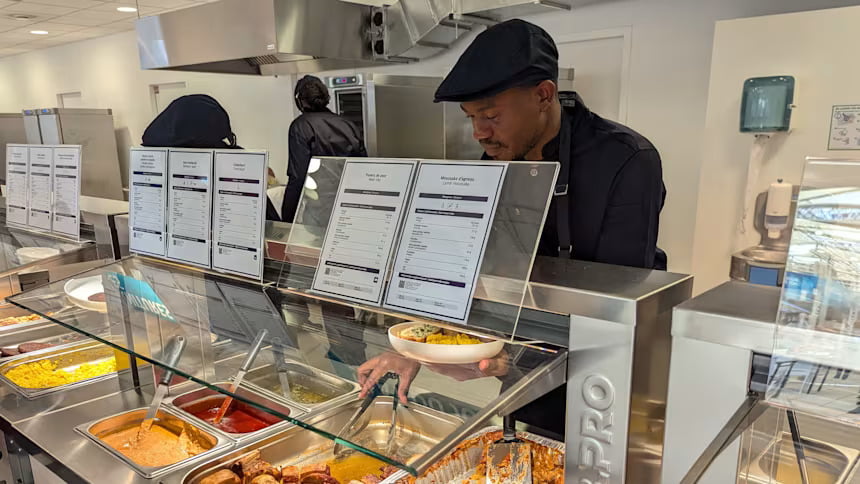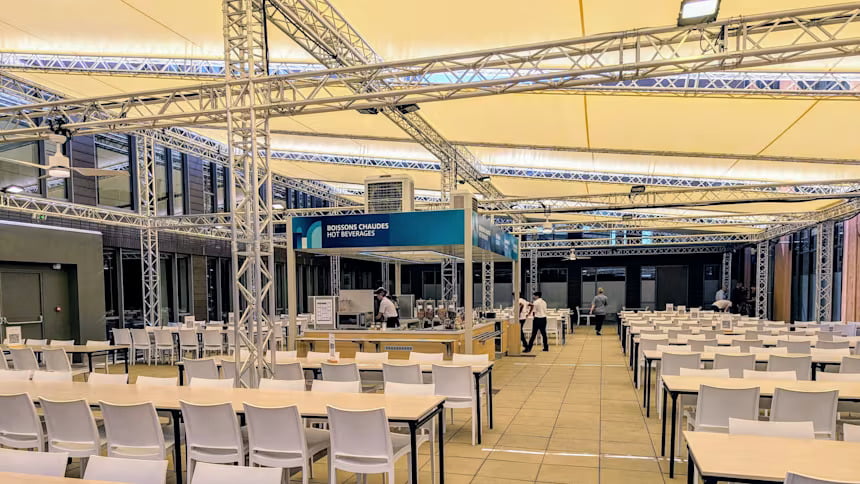The Olympic Games are not just a showcase of the world’s best athletic talent but also a testament to the immense preparation and strategy that goes into achieving peak performance. Among the many elements that contribute to an athlete’s success, nutrition plays a pivotal role. The Olympic Village, where athletes from around the globe reside during the Games, is a culinary hub that caters to the diverse dietary needs of elite competitors. Olympic Nutrition and Athletes’ Diets are meticulously planned to ensure that competitors receive the optimal balance of nutrients to enhance their performance and recovery during the Games. In this blog, we delve into the culinary aspects of the Olympic Village and explore the nutritional strategies employed by top athletes to fuel their performances.

The Culinary Wonderland of the Olympic Village
The Olympic Village is more than just a temporary home for athletes, it is a microcosm of the world, where culinary diversity meets the precise nutritional needs of the best athletes on the planet. Organizers have meticulously designed the dining halls to offer a wide array of foods that cater to different cultural preferences, dietary restrictions, and nutritional requirements.
1. Global Cuisine Under One Roof
- The Olympic Village dining hall is a sprawling facility that serves thousands of athletes daily. To accommodate diverse tastes and dietary needs, the menu features a vast selection of global cuisines. From Japanese sushi and Italian pasta to Mexican tacos and Middle Eastern falafel, athletes can enjoy flavors from home or explore new culinary delights.
- The kitchen staff prepares each meal with the highest standards of hygiene and nutrition in mind, ensuring that athletes receive clean, safe, and wholesome food.
2. Focus on Nutritional Balance
- While the variety of food is impressive, the primary focus is on providing balanced meals that align with the nutritional needs of athletes. Every dish is carefully crafted to include the right mix of macronutrients (carbohydrates, proteins, and fats) and micronutrients (vitamins and minerals) essential for optimal performance.
- The organizers offer specialized dietary options, including gluten-free, vegetarian, vegan, and halal meals, ensuring that every athlete’s dietary preferences and requirements are met.
Nutritional Strategies of Top Athletes
For top athletes, nutrition is not just about eating healthy, it’s a science that involves precise planning and timing to maximize performance and recovery. Here’s how some of the world’s best athletes approach their diets:
1. Carbohydrate Loading for Endurance
- Endurance athletes, such as marathon runners and cyclists, often employ a strategy known as carbohydrate loading. In the days leading up to a competition, they increase their intake of carbohydrates to maximize glycogen stores in their muscles. Glycogen is the primary fuel source during prolonged exercise, and having ample reserves can be the difference between winning and losing.
- The Olympic Village offers a variety of high-carb foods like pasta, rice, bread, and potatoes, allowing athletes to easily implement this strategy.
2. Protein for Muscle Repair and Growth
- Protein is essential for muscle repair and growth, especially after intense training sessions. Athletes typically consume protein-rich foods such as lean meats, fish, eggs, and plant-based options like beans and tofu. The timing of protein intake is also crucial, with many athletes opting for protein-rich meals immediately after training to kickstart the recovery process.
- The dining facilities provide a range of protein sources, ensuring that athletes can tailor their protein intake to their specific needs.
3. Hydration and Electrolyte Balance
- Maintaining hydration is critical for all athletes, particularly in hot and humid conditions. Dehydration can lead to a significant drop in performance and increase the risk of injury. In addition to water, athletes need to replenish electrolytes lost through sweat. The Olympic Village offers an array of hydration options, including water, sports drinks, and electrolyte-rich foods like bananas and leafy greens.
- Some athletes also use customized hydration strategies, such as sodium loading, to enhance their endurance during competition.
4. Timing and Frequency of Meals
- The timing of meals is another crucial aspect of an athlete’s nutritional strategy. Many athletes consume small, frequent meals throughout the day to maintain steady energy levels and prevent gastrointestinal distress during competition. Nutritionists plan competition meals to be light and easily digestible, ensuring athletes have sustained energy for peak performance.
- Post-competition, the focus shifts to recovery, with meals rich in protein and carbohydrates to replenish glycogen stores and repair muscle tissue.
The Role of Nutritionists and Chefs
Nutritionists and chefs play a crucial role in the success of Olympic athletes by ensuring they receive optimal nutrition tailored to their specific needs.
- Nutritionists: Experts collaborate with athletes to create meal plans tailored to their training, competition schedules, and health needs. They balance macronutrients (carbohydrates, proteins, fats) and micronutrients (vitamins, minerals) to fuel performance and enhance recovery. Nutritionists also help athletes manage hydration, energy levels, and dietary restrictions.
- Chefs: In the Olympic Village, chefs collaborate with nutritionists to prepare meals that meet these precise nutritional standards while also catering to diverse cultural tastes. They ensure food is nutritious, appealing, and safe, maintaining high standards of hygiene and quality. Chefs must be adaptable, offering diverse dietary options like vegetarian, gluten-free, and special diets for athletes worldwide.
- Personalized Nutrition Plans: Nutritionists create tailored meal plans for athletes, considering their sport, training intensity, and individual nutritional needs. These plans help optimize performance and recovery.
- Food Safety and Quality: Chefs ensure that all food is prepared under strict hygiene standards to prevent any risk of foodborne illnesses. They also focus on using high-quality ingredients to provide the best possible nutrition.
- Hydration Management: Both nutritionists and chefs emphasize the importance of hydration. They provide a variety of hydration options, including water, electrolyte drinks, and other beverages, to keep athletes properly hydrated.
- Adaptability: During the Olympics, athletes may face different climates and time zones. Nutritionists and chefs adapt meal plans to accommodate these changes, ensuring athletes remain in peak condition.
A “zero waste” policy and a focus on “Made in France”
Paris 2024 intends to respect its ecological commitments throughout all operations in this large-scale restaurant. The aim of the XXXIII Olympiad is to achieve “zero plastic” in catering and to halve the carbon footprint of plates.
With this in mind, 200 water, soda, and orange juice fountains have been installed, and only reusable cups are available. So goodbye plastic bottles.
The crockery is also reusable and will have a second life at the end of the Olympic and Paralympic Games. Sodexo Live!, the group in charge of the restaurants in the village, will redistribute around 35,000 plates to the kitchens
In keeping with this ecological and environmental ambition, 80 percent of the dishes served are of French origin, with 25 percent originating within a 250 km radius of the village.
Finally, Paris 2024 has signed an agreement with several associations, including the Fédération Française des Banques Alimentaires (French Federation of Food Banks), to combat food waste. Every day, these associations will collect the unconsumed food and redistribute it to people in need.

Catering at the Olympic and Paralympic Village, facts and figures
- 15,000 athletes
- Up to 40,000 meals served per day
- More than 1,000,000 meals were served during the Olympic and Paralympic Games in Paris 2024
- 3,500 seats in the Olympic and Paralympic Village canteen
- The Olympic and Paralympic Village canteen will be open 24/7 from 12 July onwards
- Over 500 recipes created by the chefs of Sodexo Live!, including 50 different hot dishes every day
- 200 cooks working every day at the Olympic and Paralympic Village
- 800 m2 of cold rooms
- 600 tons of fresh products delivered by Carrefour
- 80 per cent French products
- 30 percent organic food (or food from farms going through organic conversion)
- 100 percent of the French regions will be represented
Conclusion
The Olympic Village is a fascinating intersection of global cuisine and elite sports nutrition. It is a place where the world’s best athletes come together not just to compete, but to nourish their bodies with carefully curated meals designed to fuel their quest for gold. Nutrition is key to Olympic success, involving carbohydrate loading, protein-rich meals, and personalized hydration strategies. As athletes achieve incredible feats, remember behind every medal is a plate of perfectly balanced, nutritionally optimized food.
TO LEARN MORE CLICK BELOW
- India’s 117-strong Olympic contingent for Paris 2024
- Olympic Tourism in Paris
- Olympic Architecture and Urban Planning: Paris 2024
- Paris Olympics 2024: India’s Investment in Athletes and Sports
- Indian Chess Teams Triumph at the 2024 FIDE Chess Olympiad
- Paris 2024 Paralympic Games
- Major Stadiums in India
- IPL: Where Cricket Meets Entertainment






